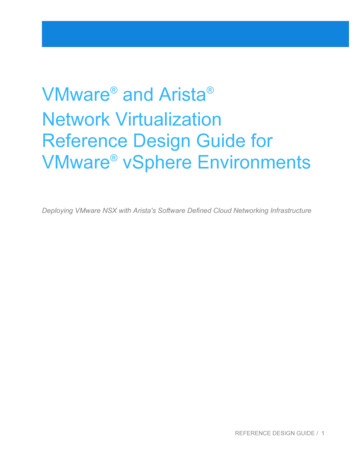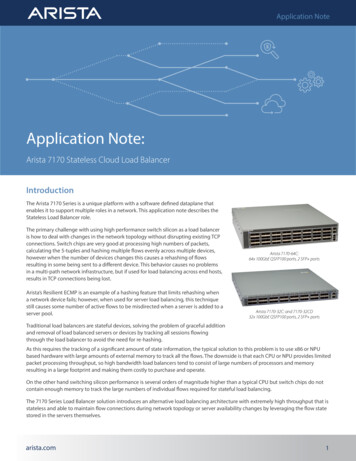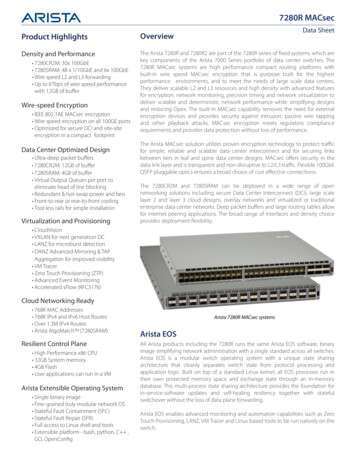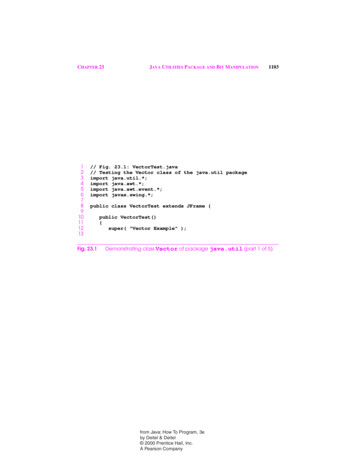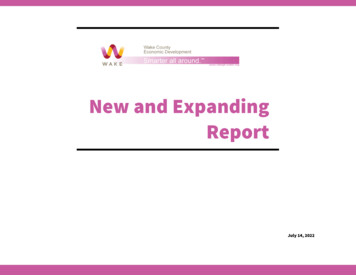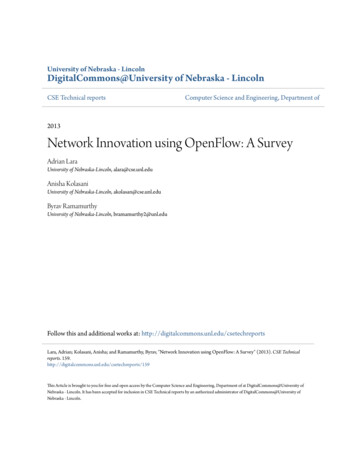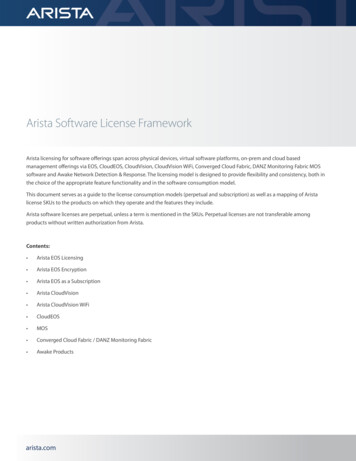
Transcription
White PaperArista AVA: The Power of AI-Driven Networkingarista.com
White PaperTable of contentsIntroduction3AVA Architecture3The AVA Advantage4AVA Delivers Solutions5Case Study 1 – Proactive Network Operations5Case Study 2 – Autonomous Network Detection and Response6Case Study 3 – Quality of Experience (QoE)8Case Study 4 – IoT Observability and Security1Case Study 5 – Enriching the Ecosystem with AVA InsightsSummary: Data-Driven Networking Made Possiblearista.com91011
White PaperIntroductionWe live in a world that is producing data at a blistering pace. A World Economic Forum study estimates that by 2025, we will becreating 463 exabytes of data every day. For context, that’s 463, followed by 18 zeros! Or as the authors put it, “Forty times morebytes than there are stars in the observable universe.” Of course, what isn’t likely to happen in that same time frame is that humanswill suddenly evolve to consider all of that available data, factor probabilities and make the right risk management decisions. That isnot to suggest that humans are becoming expendable. Far from it, we have highly tuned abilities to recognize patterns, understandabstract relationships and generalize. For instance, we don’t need hundreds or thousands of training samples to know that a userbeing targeted by a phishing attempt is the CFO of the organization. We recognize the name right away and our instincts takeover to drive remediation next steps. The task at hand is to surface just the right information to enable operators to make optimaldecisions that ultimately lead to positive business outcomes.This is where the network comes in—it is foundational to producing and consuming all of that data, and intelligent networkinfrastructure provides the goldilocks balance of “just right” information. Delivering on this promise requires two components: A system to efficiently and in real-time collect the ground truth data. Intelligence to extract the information and context buried within the raw data.Arista is uniquely positioned to deliver on both of these capabilities. Arista EOS based on NetDL , provides a multi-modal, multitenant-capable data lake that offers real-time network telemetry to other Arista solutions as well as those from our partners. AristaAVA uses an AI-driven approach to anticipate operator questions, extract answers from NetDL and deliver the insights necessary foreffective human decision making. With this combination, Arista is providing networking for the data-driven enterprise.AVA ArchitectureArista AVA is an AI-enabled decision support system that combines cloud scalability with the codified expertise of real-worldnetwork and security operations experts. Real-time, complete data, including application, in-band network telemetry, flow visibility,and complete control plane state incorporated into the Arista EOS and NetDL stack, constantly serve as the basis to train the AVAAI/ML models. These data originate from a wide range of sensors and devices, physical or virtual, or through direct integrationswith network and cloud infrastructure components such as the Arista DANZ Monitoring Fabric (DMF) or span ports on Arista EOSplatforms.Figure 1: The Arista Data-Driven Cognitive rista.com3
White PaperBased on the specific use case, AVA processes ground-truth data about the network devices’ state and, if required, raw packets topre-compute answers for questions a highly skilled analyst would ask. AVA thus surfaces the weak and early signals of a networkissue, along with corroborating evidence to establish conviction. By that same token, AVA also eliminates those signals that cannotbe corroborated so that human analysts avoid wasting valuable cycles. The net result is that the operations team is in a far betterposition to act—whether by proactively replacing network equipment due to an AVA identified “grey failure” or disrupting anadversary’s objectives at the outset because AVA identified the initial warning signs of a ransomware attack. Our field results showthat AVA frequently finds more incident-related activity than a senior human operator analyzing the same activity.The AVA AdvantageLegacy data science approaches run into some significant challenges given the scale and diversity of the modern network. Any AImodel is only as effective as the labeled samples used to train it. However, volumes of data and the types of conditions on eventhe simplest of today’s networks make effective labels scarce. In addition, given how aspects such as threats evolve rapidly, thelabels themselves become obsolete quickly, requiring frequent retraining and operational costs entailed in that effort. Even if thesechallenges are overcome, the resulting models are often massive, monolithic, and opaque, making them less useful, as they are slowand not explainable. In other words, a human analyst seeing the result often has no idea why something is flagged as a networkor security issue. Consequently, they have no idea what they should do next given the information at hand, as shown in the figurebelow.Figure 2: Challenges with legacy artificial intelligence approaches applied to network dataEven though the goal is to find the outliers and the anomalies, AVA doesn’t approach this problem like legacy AI solutions. Instead,AVA starts by learning what is normal and, dare we say, mundane. In most networks, this includes traffic such as email, patchingand even department or workgroup specific application usage. As you can imagine, there is an abundance of labels to train AVA’sML models to find these kinds of network behaviors. Unlike the approach described in Figure 1, which attempts to learn what“bad traffic” looks like, AVA works to eliminate much of the hay from the proverbial haystack of network data. This, in turn, leaves asignificantly smaller consideration set within which AVA can then look for the needles.AVA’s user experience innovation is the knowledge graph. The data AVA consumes is first processed with techniques to discover theentities—people, devices, applications, etc.—and the relationships between them. This forms the core of the knowledge graph. Thegraph can then be enhanced iteratively by knowledge from domain experts in the form of heuristics, as well as ongoing feedbackarista.com4
White Paperfrom human operators. Given the size of the knowledge graph is significantly smaller than the raw features, additional AI approachescan be applied iteratively. This not only allows for better AI analysis, but, unlike traditional ML models, with AVA, the algorithmicoutputs are captured as real-world entities and their properties. The human readable and understandable outputs deliverexplainable AI with clearly defined next steps for the analyst.AVA Delivers SolutionsThe data-driven architecture, coupled with artificial intelligence, enables several network and security operations use cases. Thissection will provide a few examples of how AVA is optimizing workflows, speeding mean time to resolution, and improving securityoutcomes.Case Study 1 – Proactive Network OperationsAVA enables network reachability modeling to deliver proactive notifications when a specific network service or application isexperiencing reachability issues. Using dynamic anomaly detection, AVA identifies anomalies based on deviations from a learnedreachability/latency baseline. The historical bounds and anomaly score adapt to normal variations as time goes on. Access to NetDL’shistorical data supports both real-time and forensic troubleshooting of any issues identified.Figure 3: AVA proactively identifies network and application reachability issuesAVA also assists with another common network operation challenge: switch table overflow, resulting in a network outage. Withthe myriad chipset implementations and associated hardware table capacities, it is difficult for operators to monitor, track andextrapolate utilization trends manually. Instead, AVA models hardware resource utilization growth trends, enabling predictivearista.com5
White Paperassessments and notification ahead of exceeding capacity. Customers use these notifications to take preventive measures and averta crisis.Finally, AVA helps minimize network performance issues and outages by predicting potential component failures. Using a supervisedmodel of subtle device changes (optical power levels and hash selection among a plethora of other features), AVA enables theidentification of ‘grey failures’ in network operations that are often the most challenging part of network troubleshooting. Byleveraging a global data set across customers to ensure the largest and most diverse training data, AVA helps refine outcomes, avoidfalse positives, and provides prescriptive recommendations to the operator.Figure 4: Detecting anomalies from a baseline enable AVA to identify grey failuresCase Study 2 – Autonomous Network Detection and ResponseLike the network operations use cases above, AVA can also deliver day 0 value to the security operations team. For instance, AVA usesunsupervised machine learning to identify and track users, devices, applications, etc., over time. AVA can also use this information tocluster similar entities. This presents a significant enhancement from legacy approaches that rely on unsupervised learning to spotanomalies from “normal” baselines for individual IP addresses rather than entities. Attributing behaviors to an IPaddress leads to high false positives and negatives, which translates to operational burdens on analysts.Similarly, AVA uses supervised machine learning to identify patterns of activity that relate to attacker tactics, techniques andprocedures. For instance, AVA can classify remote access tools, reverse shells, unauthorized applications used for command andcontrol, etc., without the need for decrypting the underlying data. This encrypted traffic analysis eliminates the privacy, policy andtechnology challenges of decrypting data for analysis.arista.com6
White PaperFigure 5: Using traffic analysis, AVA can discover malicious intent within encrypted data without the need to first decryptAnother instance of AVA driving value for the security team is the ability to autonomously pull open-source and threat intelligenceand thus, contextualize a potential threat uncovered in the environment. For example, when confronted with a suspect domain or IPaddress, much like an experienced security expert would, AVA pre-computes answers to questions such as: What other domains or destinations first showed up on the network at approximately the same time as the initial suspectdomain? Did other devices attempt to connect to any of the same domains? Was there any trace of lateral movement activity beyond the initial victim?Answering questions like these requires analyses of both internal data sources and external information via search engines, threatand vulnerability databases, etc. AVA analyzes these results using natural language processing techniques such as entity extractionand topic modeling. For the operator, the benefit is that AVA helps uncover all potential victims within the organization and differentparts of the attacker infrastructure, e.g., multiple command and control domains and Ips, all on a single screen.arista.com7
White PaperFigure 6: AVA flushes out the entire scope of an attack, enabling decisive and rapid responseCase Study 3 – Quality of Experience (QoE)AVA helps provide the networkoperator with a clear view ofthe root causes of poor userexperience and what remedialactions can be taken to improvethat experience. This day 0capability analyzes real-timedata with the benefit of labtrained models that understandthe causes of network QoEissues, their interaction and theireffects. As a specific example,AVA employs a support vectormachine (SVM) classifier todetermine the performance ofvoice and video collaborationapplications. The model is trainedusing a vast library of voice andvideo call flows labeled as a goodor bad experience.Figure 7: AVA proactively surfaces application quality of experience issues and recommends fixesarista.com8
White PaperCase Study 4 – IoT Observability and SecurityDetecting unknown IoT devices on the network offers a great example of how AVA automates human expertise.A human expert intuitively describes an IoT device as one that most often doesn’t have a browser, doesn’t use enterprise protocolslike SMB and Kerberos, and typically communicates with a small set of destinations. Using the information in NetDL, AVA can inferand index properties like these for the devices on the network, thereby easily highlighting the IoT devices. AVA then goes further byusing recommendation systems algorithms to tag other IoT devices that are not captured by the originally encoded human intuition.This iterative approach is both quick and comprehensive at the task of eliminating an important blind spot for customers dealingwith an explosion of devices on the network.Figure 8: AVA encodes human intuition to discover IoT devices on the networkConsider the following real-world customer example which illustrates the benefits of this IoT observability. An IoT device pluggedinto a critical device’s USB port was being used to intercept keystrokes between the keyboard and the computer. Detecting thisthreat first required identifying the shadow IoT device. As Figure 8 shows, the device had been sending encrypted email and aproprietary UDP stream to locations in Germany and Malaysia. These “weak signals” added further conviction, allowing AVA to triggera device quarantine by creating a ticket for the appropriate team.Figure 9: Discovering and remediating rogue IoT devices on the networkarista.com9
White PaperCase Study 5 – Enriching the Ecosystem with AVA InsightsAVA insights can also be used to enrich other parts of the customers’ IT and security ecosystem. For example, with one click, analystsusing log aggregation and SIEM tools such as Splunk or Azure Sentinel can pivot from a meaningless IP address in those tools toan AVA-enriched profile that includes the name of the device, its primary user, applications running on it and other similar devices,as well as a forensic timeline of device activities. In addition, the analyst has a detailed timeline of that device’s activities and cantherefore make appropriate risk management decisions.Figure 10: Enriching Splunk with AVA contextarista.com10
White PaperSummary: Data-Driven Networking Made PossibleThe combination of Arista AVA and EOS NetDL provides predictive and prescriptive intelligence for data-driven networks. AI/ML enrichment and analytics in combination with a broad ecosystem of vendors/partners, deliver market and customer-specificsecurity, application, and network performance analysis, feeding continuous awareness and assurance. This provides not just a singlesource of truth, but a decision support architecture for Arista customers that ultimately delivers better business outcomes.Santa Clara—Corporate Headquarters5453 Great America Parkway,Santa Clara, CA 95054Phone: 1-408-547-5500Fax: 1-408-538-8920Email: info@arista.comIreland—International Headquarters3130 Atlantic AvenueWestpark Business CampusShannon, Co. ClareIrelandIndia—R&D OfficeGlobal Tech Park, Tower A & B, 11th FloorMarathahalli Outer Ring RoadDevarabeesanahalli Village, Varthur HobliBangalore, India 560103Vancouver—R&D Office9200 Glenlyon Pkwy, Unit 300Burnaby, British ColumbiaCanada V5J 5J8Singapore—APAC Administrative Office9 Temasek Boulevard#29-01, Suntec Tower TwoSingapore 038989San Francisco—R&D and Sales Office 1390Market Street, Suite 800San Francisco, CA 94102Nashua—R&D Office10 Tara BoulevardNashua, NH 03062Copyright 2021 Arista Networks, Inc. All rights reserved. CloudVision, and EOS are registered trademarks and Arista Networksis a trademark of Arista Networks, Inc. All other company names are trademarks of their respective holders. Information in thisdocument is subject to change without notice. Certain features may not yet be available. Arista Networks, Inc. assumes noresponsibility for any errors that may appear in this document. November 2, 2021arista.com11
effective human decision making. With this combination, Arista is providing networking for the data-driven enterprise. AVA Architecture Arista AVA is an AI-enabled decision support system that combines cloud scalability with the codified expertise of real-world network and security operations experts.



